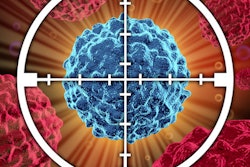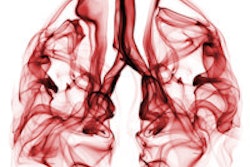Treating patients who have early-stage non-small cell lung cancer (NSCLC) with stereotactic body radiation therapy (SBRT) is associated with a small but increased risk of death from causes other than cancer, according to research presented at the European Society for Radiotherapy and Oncology (ESTRO) conference.
In particular, the researchers found that high doses to the left atrium of the heart and the superior vena cava had the strongest association and increased risk of noncancer death, said lead author Dr. Barbara Stam, PhD, from the Netherlands Cancer Institute in Amsterdam.
She and her colleagues analyzed data from 565 patients diagnosed with early NSCLC between 2006 and 2013 at five institutions in Europe and North America. All patients were treated with SBRT, which can focus radiation beams with extreme accuracy on a tumor, minimizing the effect on nearby organs. With multiple organs nearby, minimizing the dose to one organ is likely to result in a higher dose in another organ.
The researchers created a "template" image of the heart and its substructures onto which they could map the anatomy of each of the 565 patients -- a process called deformable image registration. Information on radiation dose was added, and this enabled the researchers to work out the dose parameters (such as minimum, average, and maximum doses) for the various parts of the heart such as the right and left atria, right and left ventricles, superior vena cava, descending aorta, and left pulmonary artery.
They determined the association between these dose parameters and noncancer death for each substructure and for each dose parameter. After a median follow-up of 28 months, 58% of the patients were still alive. Radiation dose to all substructures of the heart was associated with noncancer death for this group of patients. Two substructures had the strongest association with noncancer death: the maximum dose on the left atrium and the dose to a small area of the superior vena cava.
Patients with low doses on the left atrium combined with low doses on the superior vena cava had a higher chance of survival than patients with high doses on the left atrium combined with high doses on the superior vena cava, the authors found.
The associations between higher radiation doses to the left atrium and the superior vena cava and deaths from causes other than cancer were small but significant for the investigated patient group: In the left atrium, for every 1 Gy above the average dose of 7.9 Gy, the risk increased by 1.5%, while for other structures the risk increased by 1% to 2%.
The researchers do not know the causes of the noncancer deaths, as the lung cancer patients were elderly (average age, 73 years) and usually died at home with no autopsies performed. However, it's hypothesized the deaths were related to heart problems. Research in breast cancer patients, who have a much longer life expectancy than lung cancer patients, has shown that radiotherapy can affect the heart adversely.
"For early-stage lung cancer patients, treated with SBRT, we still need to investigate if heart sparing is possible, what compromises need to be made, and whether it can increase survival," Stam said in a release. "Further research and a wider discussion on heart sparing at the cost of possibly higher average lung doses is required."



















